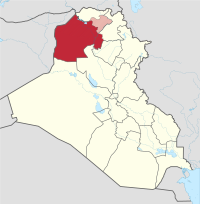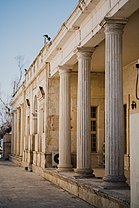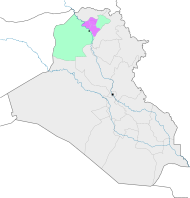Nineveh Governorate: Difference between revisions
No edit summary |
m I have only indicated the spelling preferred by the Iraqis |
||
| Line 43: | Line 43: | ||
| website = <!-- {{official URL}} --> |
| website = <!-- {{official URL}} --> |
||
}} |
}} |
||
'''Nineveh Governorate''' ({{lang-ar|محافظة نينوى}},<ref>{{cite web |title=محافظة نينوى |url=https://ninava.gov.iq/ |website=ninava.gov.iq |access-date=21 December 2019 |language=ar}}</ref> {{lang-syr|ܗܘܦܪܟܝܐ ܕܢܝܢܘܐ|Hoparkiya d’Ninwe}},<ref>{{cite web |title=Bahra Magazine |url=http://www.zowaa.co.uk/bahra/s145-1.pdf|website=zowaa.co.uk/bahra/s145-1.pdf|access-date=27 April 2020 |language=syr}}</ref><ref>Gregorius bar Hebraeus, “” based upon Jean Baptiste Abbeloos and Thomas Joseph Lamy (eds.), Gregorii Barhebræi (Louvain: Peeters, 1872-1877), Digital Syriac Corpus, last modified May 4, 2018, https://syriaccorpus.org/373.}}</ref> {{lang-ckb|پارێزگای نەینەوا|Parêzgeha Neynewa}}<ref>{{cite news |title=PDK û rewşa Civata Parêzgeha Neynewa di perlemana Îraqê de |url=https://www.kurdistan24.net/ku/news/65767e49-d7f9-4763-b03c-7b05450e4745 |access-date=21 December 2019 |work=Kurdistan24 |language=ku}}</ref><ref>{{cite news |title=ئەنجوومەنی پارێزگای نەینەوا: پارێزگار دەستیلەکارکێشایەوە و پەسەندمان کرد |url=https://www.rudaw.net/sorani/middleeast/iraq/191120191 |access-date=21 December 2019 |date=19 November 2019 |language=ku}}</ref>) is a [[Governorates of Iraq|governorate]] in northern [[Iraq]]. It has an area of {{convert|37323|km2|sqmi|abbr=on}} and an estimated population of 2,453,000 people as of 2003. Its largest city and provincial capital is [[Mosul]], which lies across the [[Tigris]] river from the ruins of ancient [[Nineveh]]. Before 1976, it was called ''Mosul Province'' and included the present-day [[Dohuk Governorate]].<ref>{{cite web |title=Ninewa - NCCI Governorate Profile |url=https://www.ncciraq.org/images/infobygov/NCCI_Ninewa_Governorate_Profile.pdf |access-date=21 December 2019 |page=4 |date=2010}}</ref> The second largest city is [[Tal Afar]], which had an almost exclusively [[Iraqi Turkmen|Turkmen]] population.<ref>{{Cite web|title=The Ba'ath Party and Insurgency in Tal Afar|url=https://www.armyupress.army.mil/Portals/7/military-review/Archives/English/MilitaryReview_2008CRII0831_art008.pdf}}</ref> |
'''Nineveh Governorate''' ({{lang-ar|محافظة نينوى}},<ref>{{cite web |title=محافظة نينوى |url=https://ninava.gov.iq/ |website=ninava.gov.iq |access-date=21 December 2019 |language=ar}}</ref> {{lang-syr|ܗܘܦܪܟܝܐ ܕܢܝܢܘܐ|Hoparkiya d’Ninwe}},<ref>{{cite web |title=Bahra Magazine |url=http://www.zowaa.co.uk/bahra/s145-1.pdf|website=zowaa.co.uk/bahra/s145-1.pdf|access-date=27 April 2020 |language=syr}}</ref><ref>Gregorius bar Hebraeus, “” based upon Jean Baptiste Abbeloos and Thomas Joseph Lamy (eds.), Gregorii Barhebræi (Louvain: Peeters, 1872-1877), Digital Syriac Corpus, last modified May 4, 2018, https://syriaccorpus.org/373.}}</ref> {{lang-ckb|پارێزگای نەینەوا|Parêzgeha Neynewa}}<ref>{{cite news |title=PDK û rewşa Civata Parêzgeha Neynewa di perlemana Îraqê de |url=https://www.kurdistan24.net/ku/news/65767e49-d7f9-4763-b03c-7b05450e4745 |access-date=21 December 2019 |work=Kurdistan24 |language=ku}}</ref><ref>{{cite news |title=ئەنجوومەنی پارێزگای نەینەوا: پارێزگار دەستیلەکارکێشایەوە و پەسەندمان کرد |url=https://www.rudaw.net/sorani/middleeast/iraq/191120191 |access-date=21 December 2019 |date=19 November 2019 |language=ku}}</ref>), to be better called Ninawa Governorate, is a [[Governorates of Iraq|governorate]] in northern [[Iraq]]. It has an area of {{convert|37323|km2|sqmi|abbr=on}} and an estimated population of 2,453,000 people as of 2003. Its largest city and provincial capital is [[Mosul]], which lies across the [[Tigris]] river from the ruins of ancient [[Nineveh]]. Before 1976, it was called ''Mosul Province'' and included the present-day [[Dohuk Governorate]].<ref>{{cite web |title=Ninewa - NCCI Governorate Profile |url=https://www.ncciraq.org/images/infobygov/NCCI_Ninewa_Governorate_Profile.pdf |access-date=21 December 2019 |page=4 |date=2010}}</ref> The second largest city is [[Tal Afar]], which had an almost exclusively [[Iraqi Turkmen|Turkmen]] population.<ref>{{Cite web|title=The Ba'ath Party and Insurgency in Tal Afar|url=https://www.armyupress.army.mil/Portals/7/military-review/Archives/English/MilitaryReview_2008CRII0831_art008.pdf}}</ref> |
||
An ethnically, religiously and culturally diverse region, it was partly conquered by [[Islamic State of Iraq and the Levant|ISIS]] in 2014.<ref>{{cite news|last1=al-Lami|first1=Mina |date=21 July 2014 |title= Iraq: the minorities of Nineveh Plain |newspaper=BBC World News |url=https://www.bbc.co.uk/news/world-middle-east-28351073 |archive-url=https://web.archive.org/web/20140724024337/http://www.bbc.co.uk/news/world-middle-east-28351073 |archive-date= 24 July 2014 |url-status=live}}</ref> Iraqi government forces [[Battle of Mosul (2016–2017)|retook the city of Mosul]] in 2017.<ref>{{cite news|title=العبادي يطلق على عمليات تحرير نينوى تسمية "قادمون يا نينوى" أمن|url=https://www.alsumaria.tv/news/182977/العبادي-يطلق-على-عمليات-تحرير-نينوى-تسمي/ar|access-date=21 October 2016|work=Al Sumaria|date=17 October 2016}}</ref><ref name="atlantic1020">{{cite news|last1=Winter|first1=Charlie|title=How ISIS Is Spinning the Mosul Battle|url=https://www.theatlantic.com/international/archive/2016/10/isis-mosul-propaganda-iraq-kurds-peshmerga/504854/|access-date=21 October 2016|work=The Atlantic|date=20 October 2016}}</ref> |
An ethnically, religiously and culturally diverse region, it was partly conquered by [[Islamic State of Iraq and the Levant|ISIS]] in 2014.<ref>{{cite news|last1=al-Lami|first1=Mina |date=21 July 2014 |title= Iraq: the minorities of Nineveh Plain |newspaper=BBC World News |url=https://www.bbc.co.uk/news/world-middle-east-28351073 |archive-url=https://web.archive.org/web/20140724024337/http://www.bbc.co.uk/news/world-middle-east-28351073 |archive-date= 24 July 2014 |url-status=live}}</ref> Iraqi government forces [[Battle of Mosul (2016–2017)|retook the city of Mosul]] in 2017.<ref>{{cite news|title=العبادي يطلق على عمليات تحرير نينوى تسمية "قادمون يا نينوى" أمن|url=https://www.alsumaria.tv/news/182977/العبادي-يطلق-على-عمليات-تحرير-نينوى-تسمي/ar|access-date=21 October 2016|work=Al Sumaria|date=17 October 2016}}</ref><ref name="atlantic1020">{{cite news|last1=Winter|first1=Charlie|title=How ISIS Is Spinning the Mosul Battle|url=https://www.theatlantic.com/international/archive/2016/10/isis-mosul-propaganda-iraq-kurds-peshmerga/504854/|access-date=21 October 2016|work=The Atlantic|date=20 October 2016}}</ref> |
||
Revision as of 13:25, 1 September 2022
Nineveh Governorate
محافظة نينوى (in Arabic) | |
|---|---|
|
Top-bottom, R-L: View over Tigris river Church of Saint Thomas • Hatra Mosul Rural area • The river's gate Mosul Museum • Heritage house | |
 | |
| Coordinates: 36°0′N 42°28′E / 36.000°N 42.467°E | |
| Country | |
| Capital | Mosul |
| Government | |
| • Governor | Najim Al-Juburee |
| Area | |
| • Total | 37,323 km2 (14,410 sq mi) |
| Population (Estimate 2018[2]) | |
| • Total | 3,730,000[1] |
| HDI (2017) | 0.664[3] medium |
Nineveh Governorate (Arabic: محافظة نينوى,[4] Syriac: ܗܘܦܪܟܝܐ ܕܢܝܢܘܐ, romanized: Hoparkiya d’Ninwe,[5][6] Sorani Kurdish: پارێزگای نەینەوا, romanized: Parêzgeha Neynewa[7][8]), to be better called Ninawa Governorate, is a governorate in northern Iraq. It has an area of 37,323 km2 (14,410 sq mi) and an estimated population of 2,453,000 people as of 2003. Its largest city and provincial capital is Mosul, which lies across the Tigris river from the ruins of ancient Nineveh. Before 1976, it was called Mosul Province and included the present-day Dohuk Governorate.[9] The second largest city is Tal Afar, which had an almost exclusively Turkmen population.[10]
An ethnically, religiously and culturally diverse region, it was partly conquered by ISIS in 2014.[11] Iraqi government forces retook the city of Mosul in 2017.[12][13]
Recent history and administration

Its two cities endured the 2003 U.S.-led invasion of Iraq and emerged unscathed. In 2004, however, Mosul and Tal Afar were the scenes of fierce battles between US-led troops and Iraqi insurgents. The insurgents moved to Nineveh after the Battle of Fallujah in 2004.
After the invasion, the military of the province was led by (then Major General) David Petraeus of the 101st Airborne Division and later by (then Brigadier General) Carter Ham as the multi-national brigade for Iraq. During the time, the American civil head of the local office of the Coalition Provisional Authority was a US Foreign Service Officer and former Kurdish refugee to the States. Mustafa administered her nominees on the provincial council and through members of the Kashmoula family.
In June 2004, Osama Kashmoula became the interim governor of the province and in September of the same year he was assassinated en route to Baghdad. He was succeeded as interim Governor by Duraid Kashmoula, who was elected governor in January 2005. Duraid Kashmoula resigned in 2009.[14] In April 2009, Atheel al-Nujaifi, a hardline Arab nationalist and member of Al-Hadba, became governor.[15] While al-Nujaifi's Arab Muttahidoon bloc lost its majority to the Kurdish Brotherhood and Coexistence Alliance List in the 2013 provincial election, al-Nujaifi was reelected as governor by a larger Sunni Arab coalition[16] that was later formalized as the Nahda Bloc.
In June 2014, insurgents from the Islamic State of Iraq and the Levant (known as ISIS or ISIL) overran the capital Mosul, forcing an estimated 500,000 refugees to flee the area,[17] including governor al-Nujaifi,[18] who was subsequently deposed by the Iraqi Parliament.[19]
While the Kurdish list proposed Hassan al-Allaf, an Arab affiliated with the Islamic Party,[20] the provincial council elected Nofal Hammadi (formerly Loyalty to Nineveh List) with the votes of the Nahdha bloc.[21]
An offensive to retake Mosul from ISIL control began in October 2016, with Iraqi and Kurdish soldiers supported by a U.S.-led coalition of 60 nations.[13]
Provincial elections
Human geography
Borders
The province borders the governorates of Dohuk, Kirkuk, Erbil, Saladin, and Anbar. It also shares a border with Syria, mostly Al-Hasakah Governorate, and Deir ez-Zor Governorate.
Administrative districts
Nineveh Governorate comprises 9 districts, listed below with their areas[22] and populations as estimated in 2018:[23]
| No. | District | Name in Arabic |
Population in 2018 |
Area in sq. km |
|---|---|---|---|---|
| 1. | Mosul | الموصل | 1,905,174 | 4,318 |
| 2. | Tel Afar | تلعفر | 511,004 | 4,286 |
| 3. | Sinjar | سنجار | 325,816 | 3,576 |
| 4. | Al-Hamdaniya | الحمدانية | 210,601 | 740.6 |
| 5. | Tel Keppe | تلكيف | 210,263 | 1,218 |
| 6. | Makhmūr | مخمور | 209,545 | 2,682 |
| 7. | Al-Ba'aj | البعاج | 179,520 | 8,359 |
| 8. | Al-Hadar (Hatra) | الحضر | 59,429 | 11,130 |
| 9. | Shekhan | شيخان | 43,984 | 466 |
| Total | 3,729,998 | 36,700 |
Demographics
| Year | Pop. | ±% p.a. | ||
|---|---|---|---|---|
| 1977 | 1,105,700 | — | ||
| 1987 | 1,479,430 | +2.95% | ||
| 1997 | 2,042,852 | +3.28% | ||
| 2009 | 3,106,948 | +3.56% | ||
| 2018 | 3,729,998 | +2.05% | ||
| ||||
| Source: Citypopulation[24] | ||||
Nineveh Province is multiethnic. There are significant numbers of Arabs, Assyrians, Turkmens, Kurds and Yazidis who live in both in towns and cities, and in their own specific villages and regions. There are also many Armenians, Kawliya, Mandeans and Shabaks.
The majority are Sunni Muslim, with 80% of the Arabs being Sunni Muslim, as well as Turkmens and Kurds also being Sunni Muslim. About 5–10% of the population is Christian. Generally, Yazidis, Shabaks and Mandeans are followers of their respective heritage religions, Yazidism, Shabakism, and Mandaeism.
The primary spoken language is Arabic. Minority languages include Turkmen, Neo-Aramaic dialects, Kurdish (predominantly Kurmanji) and Armenian.
Proposed Assyrian autonomous region
Many Assyrian leaders advocate an autonomous Assyrian homeland within the Nineveh Province (mostly in the Nineveh Plains region) for the Assyrian population.[25]
See also
- 2005 Nineveh governorate election
- Nineveh Plains
- Assyrian homeland
- List of Yazidi settlements
- List of churches and monasteries in Nineveh
- Genocide of Yazidis by ISIL
- Genocide of Christians by ISIL
- Proposals for Assyrian autonomy in Iraq
Notes and references
- ^ "Nīnawā (Governorate, Iraq) - Population Statistics, Charts, Map and Location".
- ^ "Nīnawā (Governorate, Iraq) - Population Statistics, Charts, Map and Location".
- ^ "Sub-national HDI – Area Database – Global Data Lab". hdi.globaldatalab.org. Retrieved 13 September 2018.
- ^ "محافظة نينوى". ninava.gov.iq (in Arabic). Retrieved 21 December 2019.
- ^ "Bahra Magazine" (PDF). zowaa.co.uk/bahra/s145-1.pdf (in Syriac). Retrieved 27 April 2020.
- ^ Gregorius bar Hebraeus, “” based upon Jean Baptiste Abbeloos and Thomas Joseph Lamy (eds.), Gregorii Barhebræi (Louvain: Peeters, 1872-1877), Digital Syriac Corpus, last modified May 4, 2018, https://syriaccorpus.org/373.}}
- ^ "PDK û rewşa Civata Parêzgeha Neynewa di perlemana Îraqê de". Kurdistan24 (in Kurdish). Retrieved 21 December 2019.
- ^ "ئەنجوومەنی پارێزگای نەینەوا: پارێزگار دەستیلەکارکێشایەوە و پەسەندمان کرد" (in Kurdish). 19 November 2019. Retrieved 21 December 2019.
- ^ "Ninewa - NCCI Governorate Profile" (PDF). 2010. p. 4. Retrieved 21 December 2019.
- ^ "The Ba'ath Party and Insurgency in Tal Afar" (PDF).
- ^ al-Lami, Mina (21 July 2014). "Iraq: the minorities of Nineveh Plain". BBC World News. Archived from the original on 24 July 2014.
- ^ "العبادي يطلق على عمليات تحرير نينوى تسمية "قادمون يا نينوى" أمن". Al Sumaria. 17 October 2016. Retrieved 21 October 2016.
- ^ a b Winter, Charlie (20 October 2016). "How ISIS Is Spinning the Mosul Battle". The Atlantic. Retrieved 21 October 2016.
- ^ Parker, Ned (22 January 2009). "Iraq governor looks back on troubled tenure". Los Angeles Times. Archived from the original on 11 February 2012.
- ^ Sly, Liz (23 June 2009). "In Nineveh, tensions between Iraqi Kurds and Arabs simmer". Los Angeles Times. Archived from the original on 12 February 2012.
- ^ Abdullah Salem (22 August 2013). "Voter's Revolution in Ninawa – Local minorities take over Provincial government". Niqash. Archived from the original on 22 July 2015.
- ^ Robertson, Nic & Smith-Spark, Laura (11 June 2014). "Fresh off Mosul victory, militants in Iraq wrest control of Tikrit". CNN. Archived from the original on 12 June 2014.
- ^ "Iraqi insurgents 'seize new city'". BBC News. 11 June 2014. Archived from the original on 11 June 2014.
- ^ Hamza Mustafa (29 May 2015). "Iraq: Nineveh governor sacked following ISIS advances". Asharq al-Awsat. Archived from the original on 11 February 2016.
- ^ "Member of Nineveh's Council: Two Candidates For The Post Of The Governor And Negotiations To Select One Of Them". NINA. 21 June 2015. Archived from the original on 17 February 2016.
- ^ "Nofal Hammadi of al-Nahetha bloc elected as Governor of Nineveh succeeding al-Nujaifi". Shafaq. 5 October 2015. Archived from the original on 17 February 2016. Retrieved 17 February 2016.
- ^ COSIT (Central Organization for Statistics and Information Technology), Baghdad.
- ^ "Nīnawā (Governorate, Iraq) - Population Statistics, Charts, Map and Location". www.citypopulation.de. Retrieved 25 April 2021.
- ^ "Population of Governorates". www.citypopulation.de.
- ^ Marco Gombacci. "Iraqi Christians ask EU to support the creation of a Nineveh Plain Province". europeanpost.co.
Further reading
- Kurdistan Regional Government Ministry of Extra Regional Affairs (June 2007), Report on the Administrative Changes in Kirkuk and the Disputed Regions (PDF), Erbil, archived from the original (PDF) on 11 January 2015, retrieved 5 April 2015
{{citation}}: CS1 maint: location missing publisher (link)









